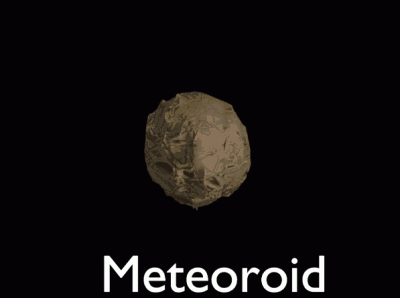The 1913 Great Meteor Procession occurred on February 9, 1913. It was a meteoric phenomenon reported from locations across Canada, the northeastern United States, and Bermuda, and from many ships at sea, including eight off Brazil, giving a total recorded ground track of over 11,000 km (7,000 miles). The meteors were particularly unusual in that there was no apparent radiant, that is to say, no point in the sky from which the meteors appeared to originate. The observations were analysed in detail, later the same year, by the astronomer Clarence Chant, leading him to conclude that as all accounts were positioned along a great circle arc, the source had been a small, short-lived natural satellite of the Earth.John A. O'Keefe, who conducted several studies of the event, proposed that the meteors should be referred to as the Cyrillids, in reference to the feast day of Cyril of Alexandria (February 9 in the Roman Catholic calendar from 1882 to 1969).
A meteoroid () is a small rocky or metallic body in outer space.
Meteoroids are significantly smaller than asteroids, and range in size from small grains to one-meter-wide objects. Objects smaller than this are classified as micrometeoroids or space dust. Most are fragments from comets or asteroids, whereas others are collision impact debris ejected from bodies such as the Moon or Mars.When a meteoroid, comet, or asteroid enters Earth's atmosphere at a speed typically in excess of 20 km/s (72,000 km/h; 45,000 mph), aerodynamic heating of that object produces a streak of light, both from the glowing object and the trail of glowing particles that it leaves in its wake. This phenomenon is called a meteor or "shooting star". Meteors typically become visible when they are about 100 km above sea level. A series of many meteors appearing seconds or minutes apart and appearing to originate from the same fixed point in the sky is called a meteor shower. A meteorite is the remains of a meteoroid that has survived the ablation of its surface material during its passage through the atmosphere as a meteor and has impacted the ground.
An estimated 25 million meteoroids, micrometeoroids and other space debris enter Earth's atmosphere each day, which results in an estimated 15,000 tonnes of that material entering the atmosphere each year.

1913Feb, 9
A group of meteors is visible across much of the eastern seaboard of North and South America, leading astronomers to conclude the source had been a small, short-lived natural satellite of the Earth.
Choose Another Date
Events on 1913
- 21Feb
Balkan Wars
Ioannina is incorporated into the Greek state after the Balkan Wars. - 25Jun
Great Reunion of 1913
American Civil War veterans begin arriving at the Great Reunion of 1913. - 3Jul
Great Reunion of 1913
Confederate veterans at the Great Reunion of 1913 reenact Pickett's Charge; upon reaching the high-water mark of the Confederacy they are met by the outstretched hands of friendship from Union survivors. - 4Jul
Great Reunion of 1913
President Woodrow Wilson addresses American Civil War veterans at the Great Reunion of 1913. - 16Aug
HMS Queen Mary
Completion of the Royal Navy battlecruiser HMS Queen Mary.

 English
English  español
español  français
français  português
português  русский
русский  العربية
العربية  简体中文
简体中文 